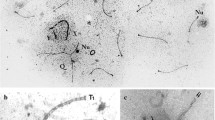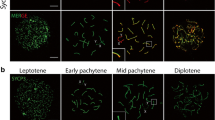Abstract
Analysis of the chromosome behaviour at pachytene has been performed by means of the silver staining technique visualizing the synaptonemal complexes (SCs) in male mice heterozygous for the male-sterile translocations T(5;12)31H, T(16;17)43H and T(7;19)145H, respectively. The T(9;17)138Ca male heterozygotes and T43H/T43H homozygous males were used as fertile controls. The sterile mice displayed a high frequency (about 60%) of pachytene spermatocytes with autosomal translocation configuration located in close vicinity of the XY pair. The dense round body (XAB), normally located near the X-chromosome axis in fertile males, exhibited abnormal affinity to translocation configuration in the sterile translocation heterozygotes. The incomplete synapsis of autosomes involved in translocation configuration was observed in more than 70% of the pachytene spermatocytes with the male-sterile translocations but in less than 20% of the cells from T138Ca fertile male.s. A hypothesis relating the spermatogenic arrest of carriers of male-sterile rearrangements to the presumed interference with X chromosome inactivation in male meiosis is discussed.
Similar content being viewed by others
References
Beechey, C.V., Kirk, M., Searle, A.G.: A reciprocal translocation induced in an oocyte and affecting fertility in male mice. Cytogenet. Cell Genet. 27, 129–146 (1980)
Boer, P. de, Branje, H.E.B.: Association of the extra chromosome of tertiary trisomic male mice with the sex chromosomes during first meiotic prophase, and its significance for impairment of spermatogenesis. Chromosoma (Berl.) 73, 369–379 (1979)
Cacheiro, N.L.A., Russell, L.B., Swartout, M.S.: Translocations, the predominant cause of total sterility in sons of mice treated with mutagens. Genetics 76, 73–91 (1974)
Chandley, A.C., Christie, S., Fletcher, J., Frackiewitz, A., Jacobs, P.A.: Translocation heterozygosity and associated subfertility in man. Cytogenetics 11, 516–533 (1972)
Chandley, A.C., Seuánez, H., Fletcher, J.M.: Meiotic behaviour of five human reciprocal translocations. Cytogenet. Cell Genet. 17, 98–111 (1976)
Cox, B.D., Lyon, M.F.: The induction by X rays of chromosome aberrations in male guinea-pigs, golden hamsters and rabbits. II. Properties of translocation induced in postmeiotic stages. Mutation Res. 29, 111–125 (1975)
Dresser, M.E., Moses, M.J.: Silver staining of synaptonemal complexes in surface spreads for light and electron microscopy. Exp. Cell Res. 121, 415–420 (1979)
Fletcher, J.M.: Light microscope analysis of meiotic prophase chromosomes by silver staining. Chromosoma (Berl.) 72, 241–248 (1979)
Forejt, J.: Nonrandom association between a specific autosome and the X chromosome in meiosis of the male mouse: possible consequence of homologous centromeres spearation. Cytogenet. Cell Genet. 13, 369–383 (1974)
Forejt, J.: Spermatogenic failure of translocation heterozygotes affected by H-2-linked gene in mouse. Nature (Lond.) 260, 143–145 (1976)
Forejt, J.: Meiotic studies of translocations causing male sterility in the mouse. II. Double heterozygotes for Robertsonian translocations. Cytogenet. Cell Genet. 23, 163–170 (1979)
Forejt, J., Čapková, J., Gregorová, S.: T(16;17)43H translocation as a tool in analysis of the proximal part of chromosome 17 (including T-t gene complex) of the mouse. Genet. Res. (Camb.) 35, 165–177 (1980)
Forejt, J., Goetz, P.: Synaptonemal complexes of mouse and human pachytene chromosomes visualized by silver staining in air-dried preparations. Chromosoma (Berl.) 73, 255–261 (1979)
Forejt, J., Gregorová, S.: Meiotic studies of translocations causing male sterility in the mouse. I. Autosomal reciprocal translocations. Cytogenet. Cell Genet. 19, 159–179 (1977)
Gregorová, S., Baranov, V.S., Forejt, J.: Partial trisomy (including T-t gene complex) of the chromosome 17 of the mouse. The effect on male fertility and the transmission to progeny. Folia biol. (Praha) (in press, 1981)
Holm, P.B., Rasmussen, S.W.: Human meiosis. III. Electron microscopical analysis of chromosome pairing in an individual with a balanced translocation 46,XY,t/5p-;22p+/. Carlsberg Res. Commun. 43, 329–350 (1978a)
Holm, P.B., Rasmussen, S.W.: Human meiosis. I. The human pachytene karyotype analyzed by three dimensional reconstruction of the synaptonemal complex. Carlsberg Res. Commun. 42, 283–323 (1978b).
Lifschytz, E., Lindsley, D.L.: The role of X-chromosome inactivation during spermatogenesis. Proc. nat. Acad. Sci. (Wash.) 69, 182–186 (1972)
Lyon, M.F., Meredith, R.: Autosomal translocations causing male sterility and viable aneuploidy in the mouse. Cytogenetics 5, 335–354 (1966)
Mazia, D., Schatten, G., Sale, W.: Adhesion of cells to surfaces coated with polylysine. J. Cell Biol. 66, 198–200 (1975)
Miklos, G.L.G.: Sex-chromosome pairing and male fertility. Cytogenet. Cell Genet. 13, 558–577 (1974)
Moses, M.J.: Synaptonemal complex karyotyping in spermatocytes of the chinese hamster (Cricetulus griseus). I. Morphology of the autosomal complement in spread preparations. Chromosoma (Berl.) 60, 99–125 (1977a)
Moses, M.J.: Synaptonemal complex karyotyping in spermatocytes of the chinese hamster (Cricetulus griseus). II. Morphology of the XY pair in spread preparations. Chromosoma (Berl.) 60, 127–137 (1977b)
Noel, B., Quack, B., Benezech, M.: Le bivalent sexual des mammifères observé par marquage argentique au stade pachytène. Ann. Génét 21, 83–87 (1978)
Pathak, S., Hsu, T.C.: Silver-stained structures in mammalian meiotic prophase. Chromosoma (Berl.) 70, 195–203 (1979)
Quack, B., Noel, B.: The XY chromosome pair in mouse and human spermatocytes visualized by silver staining. Nature (Lond.) 267, 431–433 (1977)
Searle, A.G.: Nature and consequences of induced chromosome damage in mammals. Genetics 78, 173–186 (1974)
Searle, A.G., Beechey, C.V., Evans, E.P.: Meiotic effect in chromosomally derived male sterility of mice. Ann. Biol. anim. Biochem. Biophys. 18, 391–398 (1978)
Solari, A.J.: The spatial relationship of the X and Y chromosomes during meiotic prophase in mouse spermatocytes. Chromosoma (Berl.) 29, 217–236 (1970)
Tres, L.L.: Extensive pairing of the XY bivalent in mouse spermatocytes as visualized by wholemount electron microscopy. J. Cell Sci. 25, 1–15 (1977)
Author information
Authors and Affiliations
Rights and permissions
About this article
Cite this article
Forejt, J., Gregorová, S. & Goetz, P. XY pair associates with the synaptonemal complex of autosomal male-sterile translocations in pachytene spermatocytes of the mouse (Mus musculus). Chromosoma 82, 41–53 (1981). https://doi.org/10.1007/BF00285748
Received:
Accepted:
Issue Date:
DOI: https://doi.org/10.1007/BF00285748




